check engine FIAT 124 SPIDER ABARTH 2017 2.G Owner's Manual
[x] Cancel search | Manufacturer: FIAT, Model Year: 2017, Model line: 124 SPIDER ABARTH, Model: FIAT 124 SPIDER ABARTH 2017 2.GPages: 292, PDF Size: 121.25 MB
Page 232 of 292
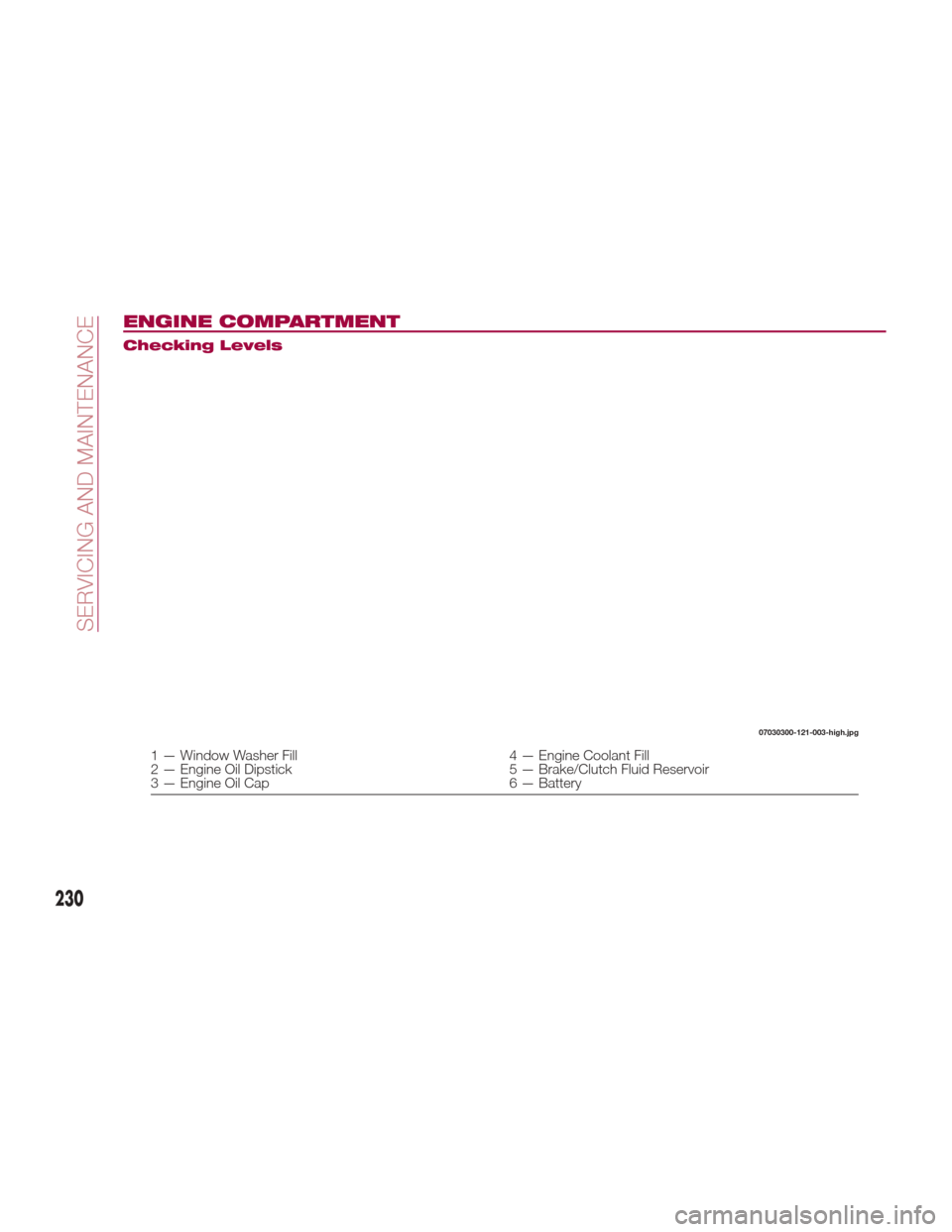
ENGINE COMPARTMENT
Checking Levels
07030300-121-003-high.jpg
1 — Window Washer Fill4 — Engine Coolant Fill
2 — Engine Oil Dipstick 5 — Brake/Clutch Fluid Reservoir
3 — Engine Oil Cap 6 — Battery
230
SERVICING AND MAINTENANCE
Page 235 of 292
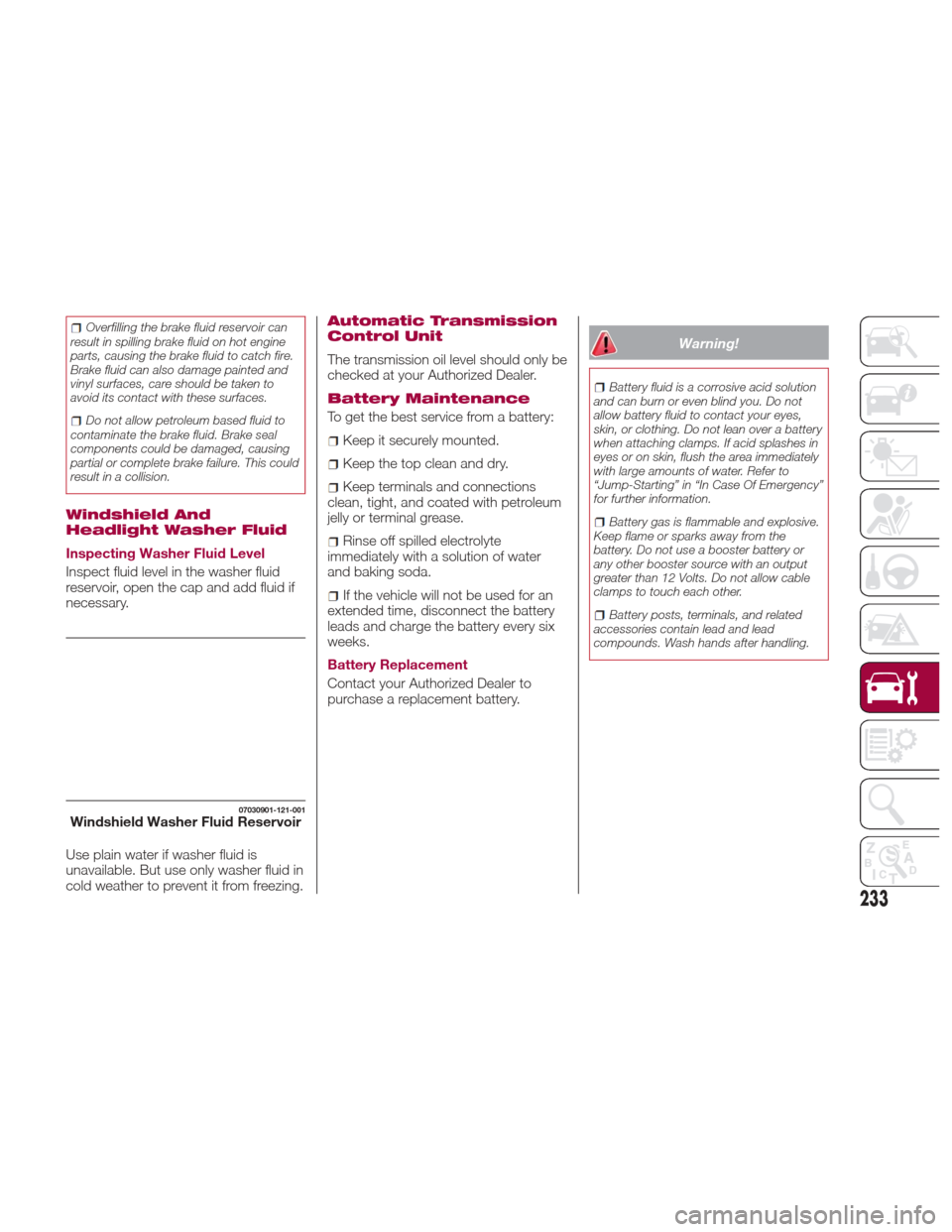
Overfilling the brake fluid reservoir can
result in spilling brake fluid on hot engine
parts, causing the brake fluid to catch fire.
Brake fluid can also damage painted and
vinyl surfaces, care should be taken to
avoid its contact with these surfaces.
Do not allow petroleum based fluid to
contaminate the brake fluid. Brake seal
components could be damaged, causing
partial or complete brake failure. This could
result in a collision.
Windshield And
Headlight Washer Fluid
Inspecting Washer Fluid Level
Inspect fluid level in the washer fluid
reservoir, open the cap and add fluid if
necessary.
Use plain water if washer fluid is
unavailable. But use only washer fluid in
cold weather to prevent it from freezing.
Automatic Transmission
Control Unit
The transmission oil level should only be
checked at your Authorized Dealer.
Battery Maintenance
To get the best service from a battery:
Keep it securely mounted.
Keep the top clean and dry.
Keep terminals and connections
clean, tight, and coated with petroleum
jelly or terminal grease.
Rinse off spilled electrolyte
immediately with a solution of water
and baking soda.
If the vehicle will not be used for an
extended time, disconnect the battery
leads and charge the battery every six
weeks.
Battery Replacement
Contact your Authorized Dealer to
purchase a replacement battery.
Warning!
Battery fluid is a corrosive acid solution
and can burn or even blind you. Do not
allow battery fluid to contact your eyes,
skin, or clothing. Do not lean over a battery
when attaching clamps. If acid splashes in
eyes or on skin, flush the area immediately
with large amounts of water. Refer to
“Jump-Starting” in “In Case Of Emergency”
for further information.
Battery gas is flammable and explosive.
Keep flame or sparks away from the
battery. Do not use a booster battery or
any other booster source with an output
greater than 12 Volts. Do not allow cable
clamps to touch each other.
Battery posts, terminals, and related
accessories contain lead and lead
compounds. Wash hands after handling.
07030901-121-001Windshield Washer Fluid Reservoir
233
Page 236 of 292
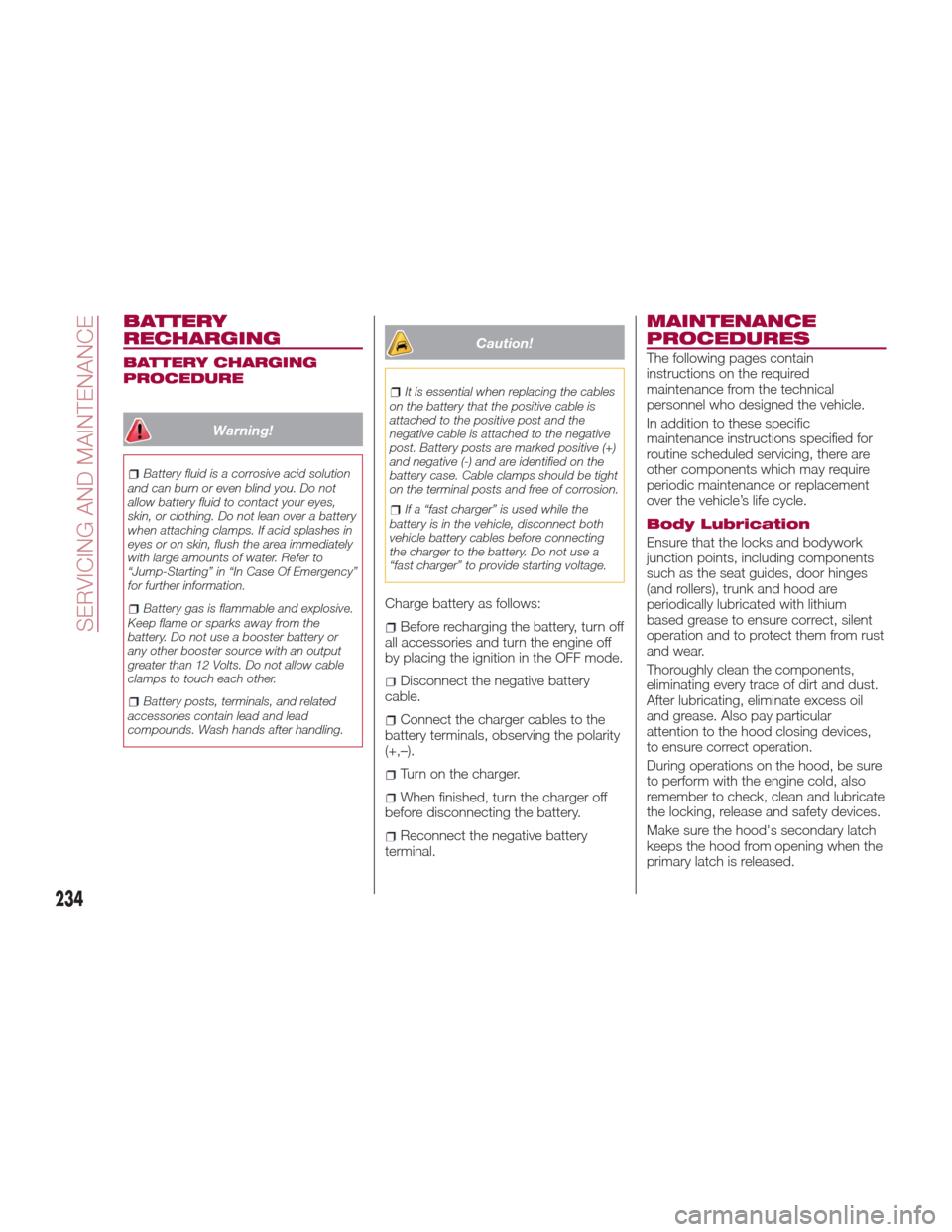
BATTERY
RECHARGING
BATTERY CHARGING
PROCEDURE
Warning!
Battery fluid is a corrosive acid solution
and can burn or even blind you. Do not
allow battery fluid to contact your eyes,
skin, or clothing. Do not lean over a battery
when attaching clamps. If acid splashes in
eyes or on skin, flush the area immediately
with large amounts of water. Refer to
“Jump-Starting” in “In Case Of Emergency”
for further information.
Battery gas is flammable and explosive.
Keep flame or sparks away from the
battery. Do not use a booster battery or
any other booster source with an output
greater than 12 Volts. Do not allow cable
clamps to touch each other.
Battery posts, terminals, and related
accessories contain lead and lead
compounds. Wash hands after handling.
Caution!
It is essential when replacing the cables
on the battery that the positive cable is
attached to the positive post and the
negative cable is attached to the negative
post. Battery posts are marked positive (+)
and negative (-) and are identified on the
battery case. Cable clamps should be tight
on the terminal posts and free of corrosion.
If a “fast charger” is used while the
battery is in the vehicle, disconnect both
vehicle battery cables before connecting
the charger to the battery. Do not use a
“fast charger” to provide starting voltage.
Charge battery as follows:
Before recharging the battery, turn off
all accessories and turn the engine off
by placing the ignition in the OFF mode.
Disconnect the negative battery
cable.
Connect the charger cables to the
battery terminals, observing the polarity
(+,–).
Turn on the charger.
When finished, turn the charger off
before disconnecting the battery.
Reconnect the negative battery
terminal.
MAINTENANCE
PROCEDURES
The following pages contain
instructions on the required
maintenance from the technical
personnel who designed the vehicle.
In addition to these specific
maintenance instructions specified for
routine scheduled servicing, there are
other components which may require
periodic maintenance or replacement
over the vehicle’s life cycle.
Body Lubrication
Ensure that the locks and bodywork
junction points, including components
such as the seat guides, door hinges
(and rollers), trunk and hood are
periodically lubricated with lithium
based grease to ensure correct, silent
operation and to protect them from rust
and wear.
Thoroughly clean the components,
eliminating every trace of dirt and dust.
After lubricating, eliminate excess oil
and grease. Also pay particular
attention to the hood closing devices,
to ensure correct operation.
During operations on the hood, be sure
to perform with the engine cold, also
remember to check, clean and lubricate
the locking, release and safety devices.
Make sure the hood's secondary latch
keeps the hood from opening when the
primary latch is released.
234
SERVICING AND MAINTENANCE
Page 254 of 292
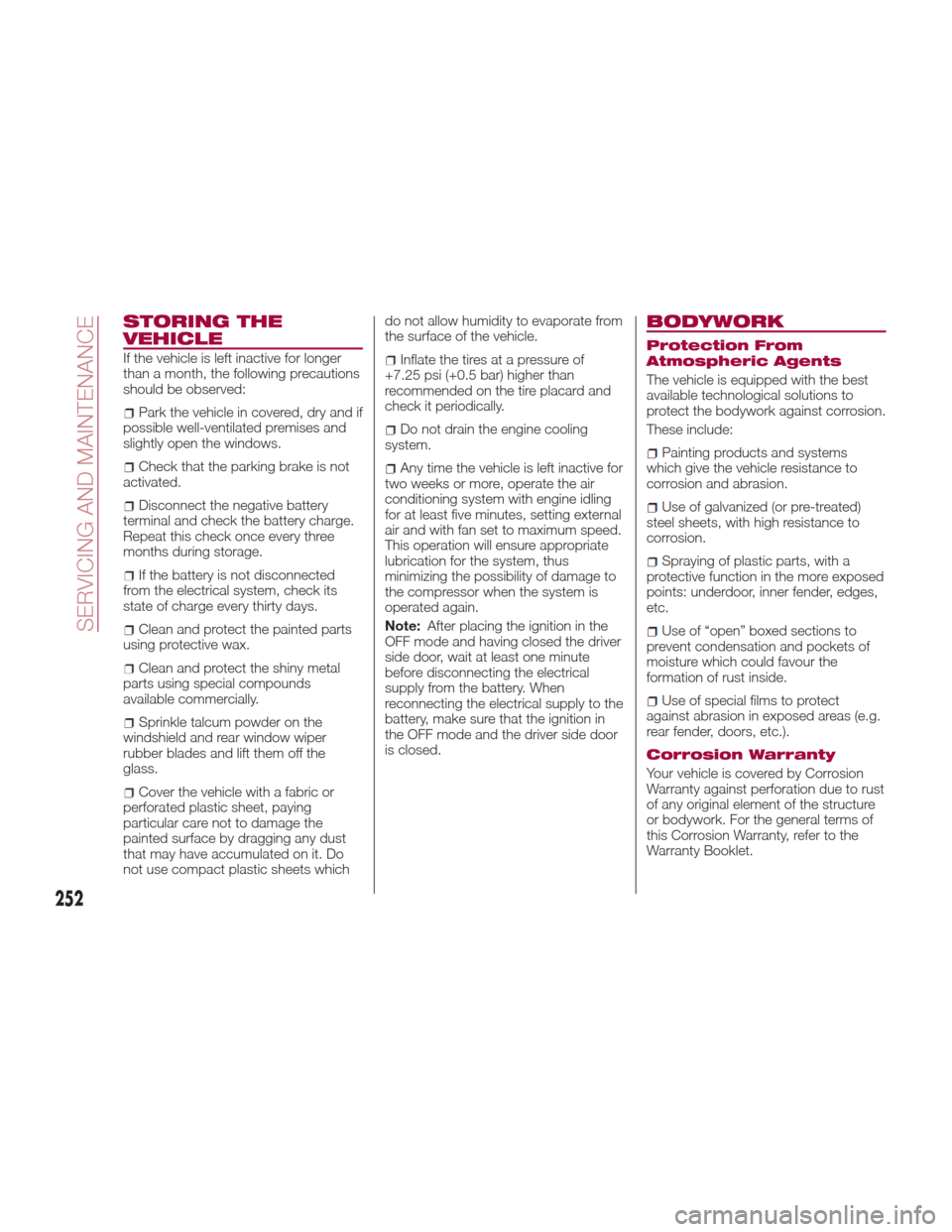
STORING THE
VEHICLE
If the vehicle is left inactive for longer
than a month, the following precautions
should be observed:
Park the vehicle in covered, dry and if
possible well-ventilated premises and
slightly open the windows.
Check that the parking brake is not
activated.
Disconnect the negative battery
terminal and check the battery charge.
Repeat this check once every three
months during storage.
If the battery is not disconnected
from the electrical system, check its
state of charge every thirty days.
Clean and protect the painted parts
using protective wax.
Clean and protect the shiny metal
parts using special compounds
available commercially.
Sprinkle talcum powder on the
windshield and rear window wiper
rubber blades and lift them off the
glass.
Cover the vehicle with a fabric or
perforated plastic sheet, paying
particular care not to damage the
painted surface by dragging any dust
that may have accumulated on it. Do
not use compact plastic sheets which do not allow humidity to evaporate from
the surface of the vehicle.
Inflate the tires at a pressure of
+7.25 psi (+0.5 bar) higher than
recommended on the tire placard and
check it periodically.
Do not drain the engine cooling
system.
Any time the vehicle is left inactive for
two weeks or more, operate the air
conditioning system with engine idling
for at least five minutes, setting external
air and with fan set to maximum speed.
This operation will ensure appropriate
lubrication for the system, thus
minimizing the possibility of damage to
the compressor when the system is
operated again.
Note: After placing the ignition in the
OFF mode and having closed the driver
side door, wait at least one minute
before disconnecting the electrical
supply from the battery. When
reconnecting the electrical supply to the
battery, make sure that the ignition in
the OFF mode and the driver side door
is closed.
BODYWORK
Protection From
Atmospheric Agents
The vehicle is equipped with the best
available technological solutions to
protect the bodywork against corrosion.
These include:
Painting products and systems
which give the vehicle resistance to
corrosion and abrasion.
Use of galvanized (or pre-treated)
steel sheets, with high resistance to
corrosion.
Spraying of plastic parts, with a
protective function in the more exposed
points: underdoor, inner fender, edges,
etc.
Use of “open” boxed sections to
prevent condensation and pockets of
moisture which could favour the
formation of rust inside.
Use of special films to protect
against abrasion in exposed areas (e.g.
rear fender, doors, etc.).
Corrosion Warranty
Your vehicle is covered by Corrosion
Warranty against perforation due to rust
of any original element of the structure
or bodywork. For the general terms of
this Corrosion Warranty, refer to the
Warranty Booklet.
252
SERVICING AND MAINTENANCE
Page 266 of 292

Engine Number
The engine number label is located on
the engine.
RECOMMENDED
TIRE INFLATION
PRESSURE
On the tire label you will find the
recommended tire inflation pressure in
both psi and kPa for the tires installed
as original equipment on the vehicle.
It is very important that the inflation
pressure of the tires on your vehicle is
maintained at the recommended
pressure.
You should check the tire pressure
regularly to insure that the proper
inflation pressure is maintained.
Note:
Tire pressures listed on the vehicle
placard or tire information label indicate
the recommended cold tire inflation
pressure, measured when the tires are
cold, after the vehicle has been parked
for at least three hours. As you drive,
the temperature in the tire warms up,
increasing the tire pressure.
Always check the tire inflation
pressures on a regular basis according
to the recommended tire inflation
pressure on the tire label and in
conjunction with the information in this
Owner's Manual. Driving your vehicle
with under-inflated tires is dangerous.
Under-inflation is the most common
cause of failures in any kind of tire and
may result in severe cracking, tread
separation or “blowout”, with
unexpected loss of vehicle control and
increased risk of injury. Under-inflation
increases sidewall flexing and rolling
resistance, resulting in heat buildup
and internal damage to the tire. It
results in unnecessary tire stress,
irregular wear, loss of control and
accidents. A tire can lose up to half of
its air pressure and not appear to be
flat. It is impossible to determine
whether or not tires are properly
inflated just by looking at them.
10010107-121-002-high.jpgTire Pressure Label
264
TECHNICAL SPECIFICATIONS
Page 280 of 292
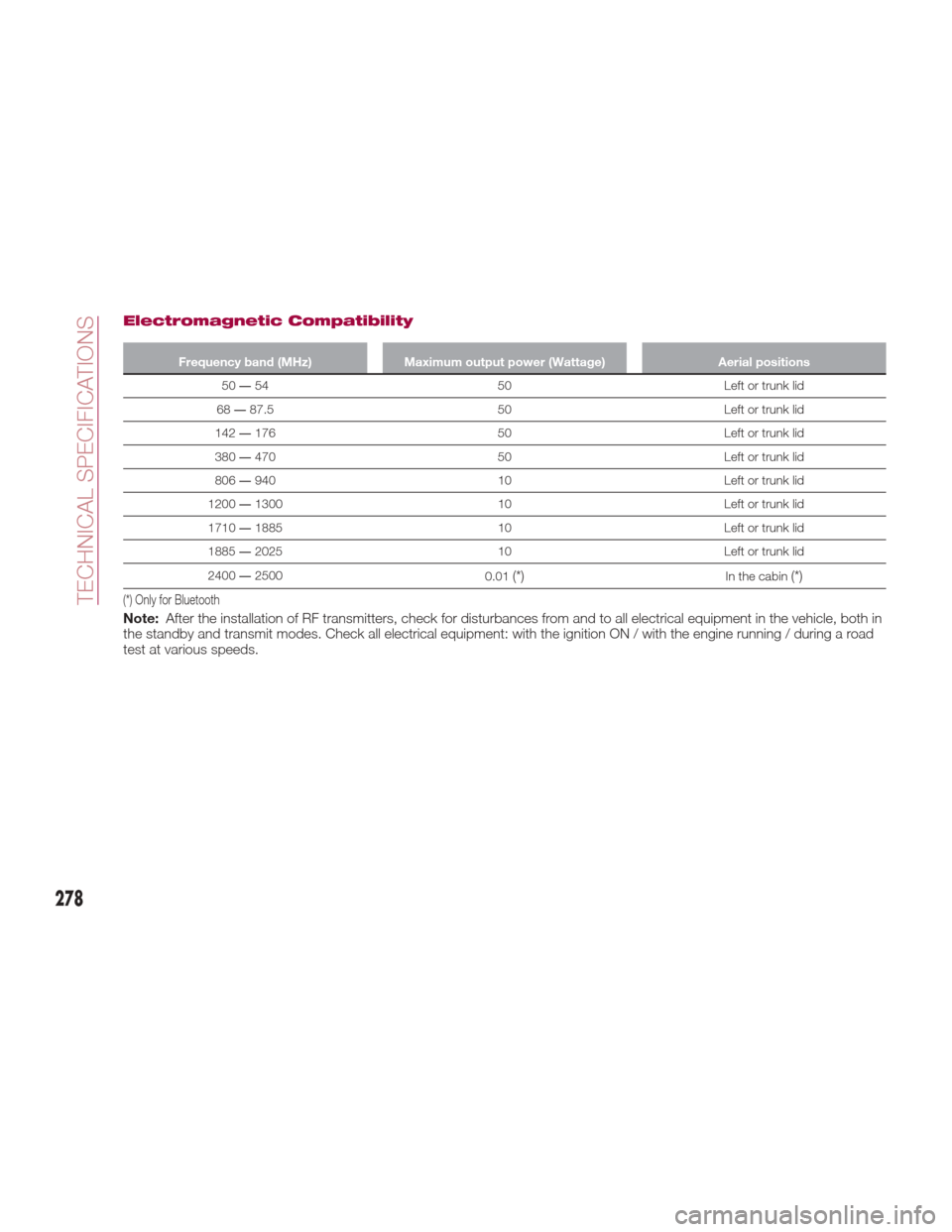
Electromagnetic Compatibility
Frequency band (MHz)Maximum output power (Wattage) Aerial positions
50 ―54
50Left or trunk lid
68 ―87.5 50Left or trunk lid
142 ―176 50Left or trunk lid
380 ―470 50Left or trunk lid
806 ―940 10Left or trunk lid
1200 ―1300 10Left or trunk lid
1710 ―1885 10Left or trunk lid
1885 ―2025 10Left or trunk lid
2400 ―2500
0.01
(*)In the cabin(*)
(*) Only for Bluetooth
Note:After the installation of RF transmitters, check for disturbances from and to all electrical equipment in the vehicle, both in
the standby and transmit modes. Check all electrical equipment: with the ignition ON / with the engine running / during a road
test at various speeds.
278
TECHNICAL SPECIFICATIONS
Page 287 of 292
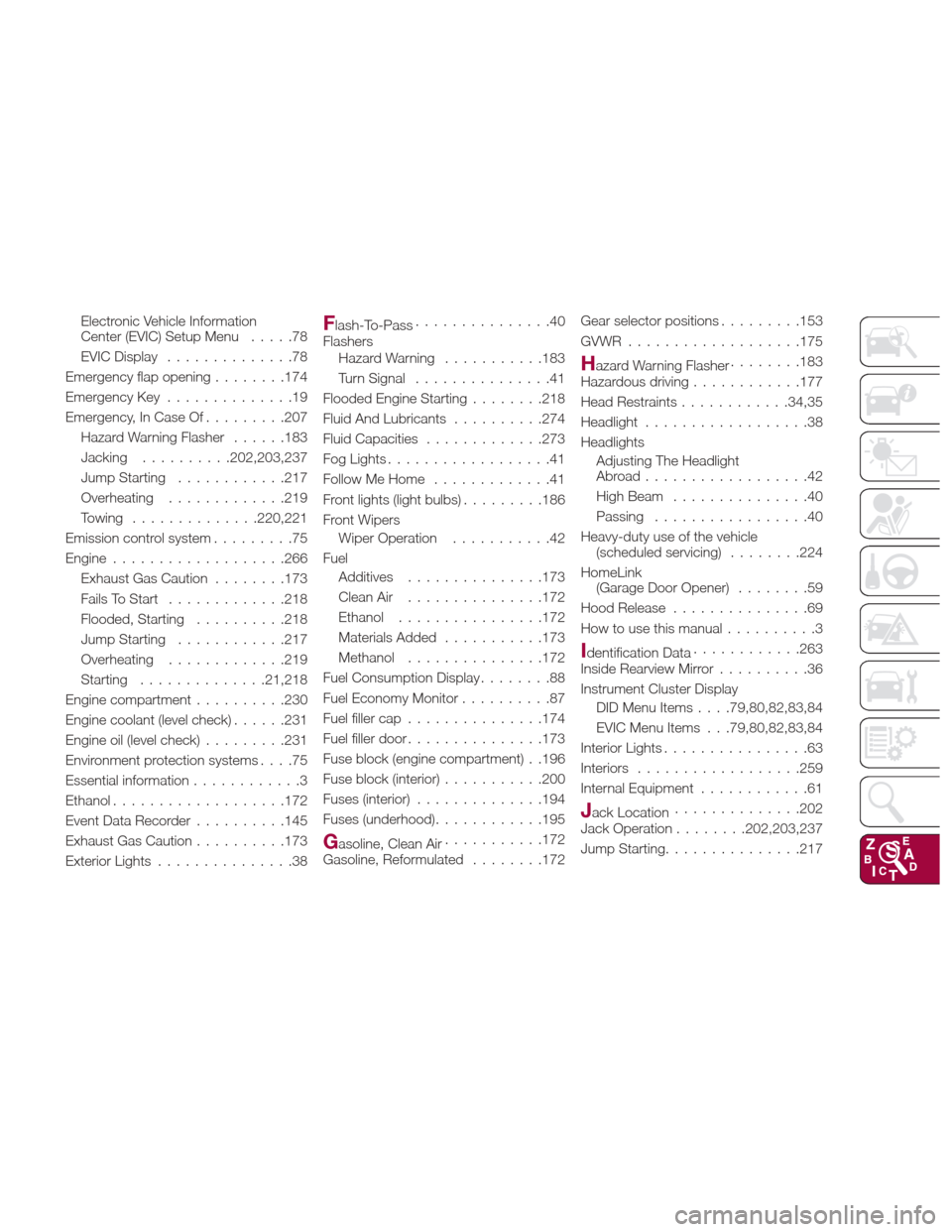
Electronic Vehicle Information
Center (EVIC) Setup Menu.....78
EVIC Display ..............78
Emergency flap opening ........174
Emergency Key ..............19
Emergency, In Case Of .........207
Hazard Warning Flasher ......183
Jacking ..........202,203,237
Jump Starting ............217
Overheating .............219
Towing ............. .220,221
Emission control system .........75
Engine .................. .266
Exhaust Gas Caution ........173
Fails To Start .............218
Flooded, Starting ..........218
Jump Starting ............217
Overheating .............219
Starting ..............21,218
Engine compartment ..........230
Engine coolant (level check) ......231
Engine oil (level check) .........231
Environment protection systems ....75
Essential information ............3
Ethanol .................. .172
Event Data Recorder ..........145
Exhaust Gas Caution ..........173
Exterior Lights ...............38Flash-To-Pass...............40
Flashers Hazard Warning ...........183
Turn Signal ...............41
Flooded Engine Starting ........218
Fluid And Lubricants ..........274
Fluid Capacities .............273
Fog Lights ..................41
Follow Me Home .............41
Front lights (light bulbs) .........186
Front Wipers Wiper Operation ...........42
Fuel Additives ...............173
Clean Air ...............172
Ethanol ............... .172
Materials Added ...........173
Methanol ...............172
Fuel Consumption Display ........88
Fuel Economy Monitor ..........87
Fuel filler cap ...............174
Fuel filler door ...............173
Fuse block (engine compartment) . .196
Fuse block (interior) ...........200
Fuses (interior) ..............194
Fuses (underhood) ............195
Gasoline, Clean Air...........172
Gasoline, Reformulated ........172Gear selector positions
.........153
GVWR .................. .175
Hazard Warning Flasher........183
Hazardous driving ............177
Head Restraints ............34,35
Headlight ..................38
Headlights Adjusting The Headlight
Abroad..................42
High Beam ...............40
Passing .................40
Heavy-duty use of the vehicle (scheduled servicing) ........224
HomeLink (Garage Door Opener) ........59
Hood Release ...............69
How to use this manual ..........3
Identification Data............263
Inside Rearview Mirror ..........36
Instrument Cluster Display DID Menu Items . . . .79,80,82,83,84
EVIC Menu Items . . .79,80,82,83,84
Interior Lights ................63
Interiors ................. .259
Internal Equipment ............61
Jack Location..............202
Jack Operation ........202,203,237
Jump Starting ...............217
Page 288 of 292
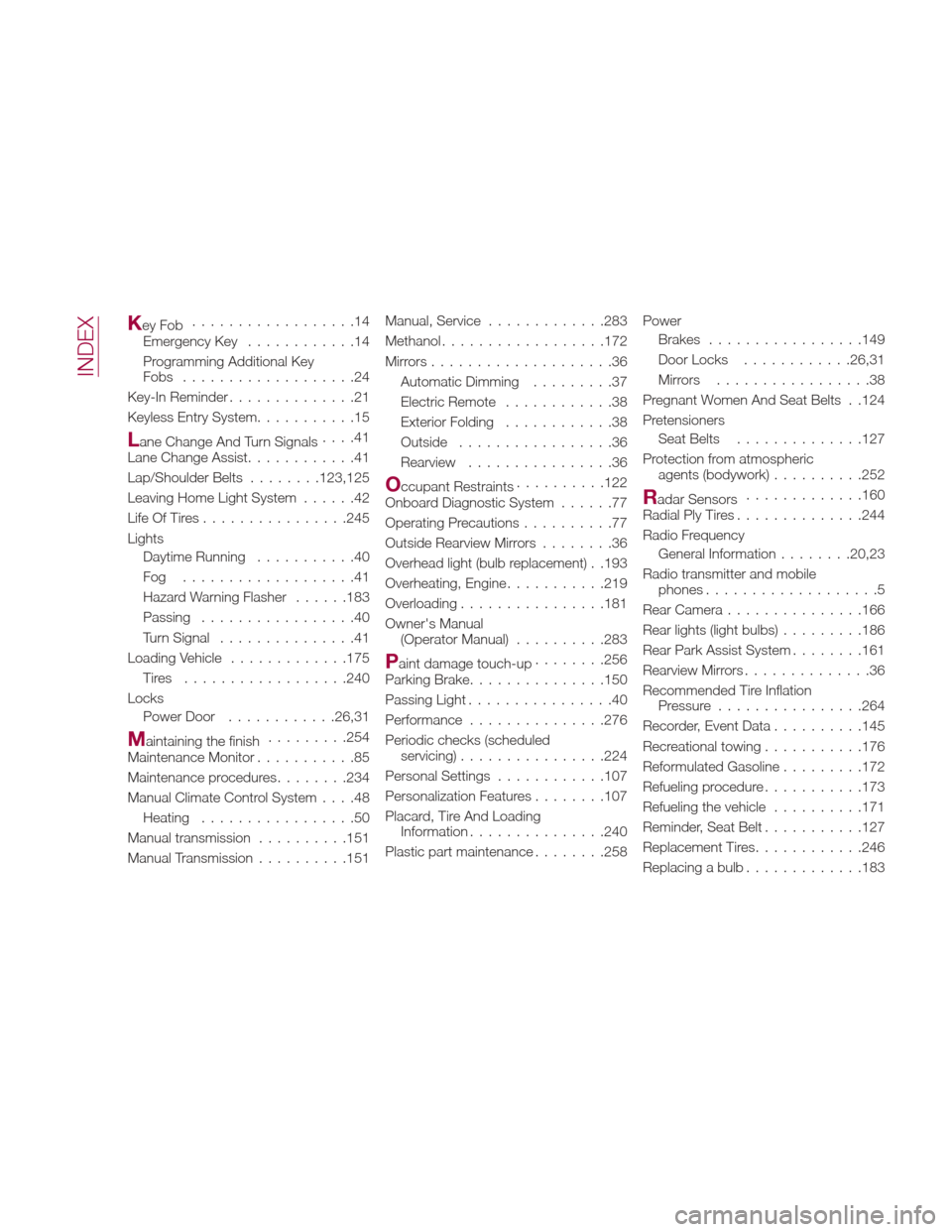
Key Fob..................14
Emergency Key ............14
Programming Additional Key
Fobs ...................24
Key-In Reminder ..............21
Keyless Entry System...........15
Lane Change And Turn Signals ....41
Lane Change Assist ............41
Lap/Shoulder Belts ........123,125
Leaving Home Light System ......42
Life Of Tires ............... .245
Lights Daytime Running ...........40
Fog ...................41
Hazard Warning Flasher ......183
Passing .................40
Turn Signal ...............41
Loading Vehicle .............175
Tires ................. .240
Locks PowerDoor ........... .26,31
Maintaining the finish.........254
Maintenance Monitor ...........85
Maintenance procedures ........234
Manual Climate Control System ....48
Heating .................50
Manual transmission ..........151
Manual Transmission ..........151Manual, Service
.............283
Methanol ................. .172
Mirrors....................36 Automatic Dimming .........37
Electric Remote ............38
Exterior Folding ............38
Outside .................36
Rearview ................36
Occupant Restraints ..........122
Onboard Diagnostic System ......77
Operating Precautions ..........77
Outside Rearview Mirrors ........36
Overhead light (bulb replacement) . .193
Overheating, Engine ...........219
Overloading ............... .181
Owner's Manual (Operator Manual) ..........283
Paint damage touch-up ........256
Parking Brake ...............150
Passing Light ................40
Performance ...............276
Periodic checks (scheduled servicing) ............... .224
Personal Settings ............107
Personalization Features ........107
Placard, Tire And Loading Information ...............240
Plastic part maintenance ........258Power
Brakes ................ .149
Door Locks ............26,31
Mirrors .................38
Pregnant Women And Seat Belts . .124
Pretensioners Seat Belts ..............127
Protection from atmospheric agents (bodywork) ..........252
Radar Sensors.............160
Radial Ply Tires ..............244
Radio Frequency General Information ........20,23
Radio transmitter and mobile phones ...................5
Rear Camera ...............166
Rear lights (light bulbs) .........186
Rear Park Assist System ........161
Rearview Mirrors ..............36
Recommended Tire Inflation Pressure ............... .264
Recorder, Event Data ..........145
Recreational towing ...........176
Reformulated Gasoline .........172
Refueling procedure ...........173
Refueling the vehicle ..........171
Reminder, Seat Belt ...........127
Replacement Tires ............246
Replacing a bulb .............183
INDEX